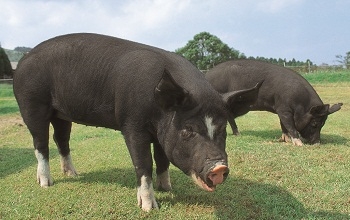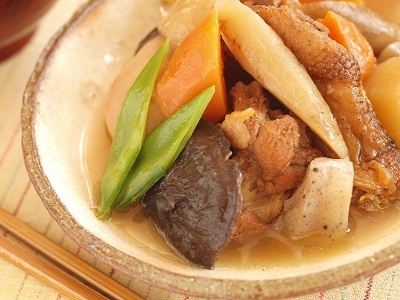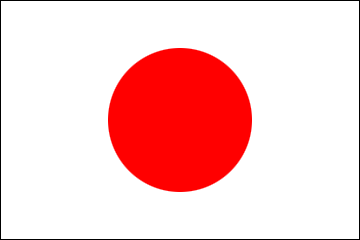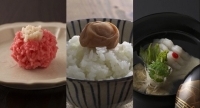Japanese Kitchen
2020/6/16
The fifth instalment of our Japanese Kitchen series takes us to the southern island of Kyushu, to Kagoshima. In contrast to the northern island of Hokkaido featured in the previous article, Kyushu boasts a mild, subtropical climate and plenty of sunshine. It also has a long history with the UK as it is believed that the first Englishman ever to travel to Japan, William Adams, arrived there in 1600.
Jidori-no-nitsuke (Simmered native chicken)
By Junichiro Yamakuchi
originally published in May 2014
 Although pork is eaten generally in Japan, as introduced last month, the name of high quality pork is closely associated with "Kuro Buta" pork for many Japanese people. "Kuro Buta", popular for its rich taste and tenderness, is mostly produced in my home prefecture of Kagoshima.
Although pork is eaten generally in Japan, as introduced last month, the name of high quality pork is closely associated with "Kuro Buta" pork for many Japanese people. "Kuro Buta", popular for its rich taste and tenderness, is mostly produced in my home prefecture of Kagoshima.
Satsuma, which is the old name for Kagoshima, located in the south of Kyushu Island, has been famous for its Spartan character since ancient times. The Satsuma samurai were known for their strength during the Sengoku period (or Warring States period). A significant factor in this regard was their meat diet. Although most Japanese at that time didn’t eat meat, the young men of Satsuma had the custom of consuming pork.
The Berkshire breed was introduced to Kagoshima from Britain about 120 years ago. The meaning of "Kuro Buta" in Japanese is "black pig." In Japan, only the meat of pure Berkshire pigs can be called "Kuro Buta."
The relationship between Satsuma and Britain suffered turbulent times, notably the attack on British merchants by Satsuma samurai (1862) and the subsequent Anglo-Satsuma war, but was strengthened during the end of the Togugawa Era when state-of-the-art arms supplied from Britain became a driving force of the subsequent Meiji Restoration. In 1865, 19 students from Satsuma came to the UK to study and on their return took back much British expertise and knowledge. Next year, 2015, sees the 150th anniversary of the arrival of these students and organisations from the UK and Japan will hold some commemorative events. (Please keep an eye on the Embassy website for further information on this subject).
 Getting back to eating habits, in Kagoshima, chicken used to be eaten as well as pork. People raised their own poultry and cooked them only on New Year’s Day or on days when they had guests. The dish would make at that time is called “Jidori-no-nitsuke”. For my grandfather's generation it was a great dinner! Since the chicken (thigh on the bone) is well boiled, the tender meat falls easily off the bone when eaten with chopsticks. When I was young, I clearly remember this meal was always served at parties and gatherings.
Getting back to eating habits, in Kagoshima, chicken used to be eaten as well as pork. People raised their own poultry and cooked them only on New Year’s Day or on days when they had guests. The dish would make at that time is called “Jidori-no-nitsuke”. For my grandfather's generation it was a great dinner! Since the chicken (thigh on the bone) is well boiled, the tender meat falls easily off the bone when eaten with chopsticks. When I was young, I clearly remember this meal was always served at parties and gatherings.
As an aside, Kagoshima cuisine seems somewhat sweet to the people outside the prefecture. Although brown sugar may be used for seasoning in some cases, in fact the soy sauce of Kagoshima itself is sweet. After growing up for 18 years with this sweet soy sauce, I experienced the Tokyo variety only after moving there for university. Since it was unusually salty when I ate sliced raw fish, at first I was confused as to whether my tongue was working properly or not!
My wife, by contrast, grew up around Tokyo and says that raw fish Kagoshima soy sauce is too sweet to eat. But I believe the tenderness and rich taste of the simmered chicken and vegetables are derived from this sweet soy source.
Unfortunately, the sweet soy sauce of Kagoshima is not available at present in the UK. However, since “Shochu” (a white distilled liquor and speciality of Kagoshima) is sold in Britain these days, and it is part of my job to promote the sale of Japanese food here, I look forward to the day when everyone can enjoy the taste of “Jidori-no-nitsuke” seasoned with the soy sauce of Kagoshima with Shochu in the UK. Please do have a go at making it yourself with this simple recipe below!
originally published in May 2014
 Although pork is eaten generally in Japan, as introduced last month, the name of high quality pork is closely associated with "Kuro Buta" pork for many Japanese people. "Kuro Buta", popular for its rich taste and tenderness, is mostly produced in my home prefecture of Kagoshima.
Although pork is eaten generally in Japan, as introduced last month, the name of high quality pork is closely associated with "Kuro Buta" pork for many Japanese people. "Kuro Buta", popular for its rich taste and tenderness, is mostly produced in my home prefecture of Kagoshima.Satsuma, which is the old name for Kagoshima, located in the south of Kyushu Island, has been famous for its Spartan character since ancient times. The Satsuma samurai were known for their strength during the Sengoku period (or Warring States period). A significant factor in this regard was their meat diet. Although most Japanese at that time didn’t eat meat, the young men of Satsuma had the custom of consuming pork.
The Berkshire breed was introduced to Kagoshima from Britain about 120 years ago. The meaning of "Kuro Buta" in Japanese is "black pig." In Japan, only the meat of pure Berkshire pigs can be called "Kuro Buta."
The relationship between Satsuma and Britain suffered turbulent times, notably the attack on British merchants by Satsuma samurai (1862) and the subsequent Anglo-Satsuma war, but was strengthened during the end of the Togugawa Era when state-of-the-art arms supplied from Britain became a driving force of the subsequent Meiji Restoration. In 1865, 19 students from Satsuma came to the UK to study and on their return took back much British expertise and knowledge. Next year, 2015, sees the 150th anniversary of the arrival of these students and organisations from the UK and Japan will hold some commemorative events. (Please keep an eye on the Embassy website for further information on this subject).
 Getting back to eating habits, in Kagoshima, chicken used to be eaten as well as pork. People raised their own poultry and cooked them only on New Year’s Day or on days when they had guests. The dish would make at that time is called “Jidori-no-nitsuke”. For my grandfather's generation it was a great dinner! Since the chicken (thigh on the bone) is well boiled, the tender meat falls easily off the bone when eaten with chopsticks. When I was young, I clearly remember this meal was always served at parties and gatherings.
Getting back to eating habits, in Kagoshima, chicken used to be eaten as well as pork. People raised their own poultry and cooked them only on New Year’s Day or on days when they had guests. The dish would make at that time is called “Jidori-no-nitsuke”. For my grandfather's generation it was a great dinner! Since the chicken (thigh on the bone) is well boiled, the tender meat falls easily off the bone when eaten with chopsticks. When I was young, I clearly remember this meal was always served at parties and gatherings.As an aside, Kagoshima cuisine seems somewhat sweet to the people outside the prefecture. Although brown sugar may be used for seasoning in some cases, in fact the soy sauce of Kagoshima itself is sweet. After growing up for 18 years with this sweet soy sauce, I experienced the Tokyo variety only after moving there for university. Since it was unusually salty when I ate sliced raw fish, at first I was confused as to whether my tongue was working properly or not!
My wife, by contrast, grew up around Tokyo and says that raw fish Kagoshima soy sauce is too sweet to eat. But I believe the tenderness and rich taste of the simmered chicken and vegetables are derived from this sweet soy source.
Unfortunately, the sweet soy sauce of Kagoshima is not available at present in the UK. However, since “Shochu” (a white distilled liquor and speciality of Kagoshima) is sold in Britain these days, and it is part of my job to promote the sale of Japanese food here, I look forward to the day when everyone can enjoy the taste of “Jidori-no-nitsuke” seasoned with the soy sauce of Kagoshima with Shochu in the UK. Please do have a go at making it yourself with this simple recipe below!
Photograph provided by Kirishima Shokuiku Kenkyukai
Jidori no Nitsuke (Kiikon) recipe
Ingredients (for 2 - 4 people)
*Daikon (white mooli) can be bought in the major British supermarkets or Asian stores. Peel the skin before use.
*Konnyaku, called “Devil’s tongue” in English, is a jelly-like substance made from sticky potato. It is very low in calories and rich in fibre. It is a popular ingredient in Japanese cuisine. Available from Japanese supermarkets and perhaps some bigger UK supermarkets. Can be omitted if necessary.
*Atsu-age is think fried tofu, used often in cooked food in Japan. If not available you can replace it with hard-type tofu (without any flavour).
*Gobo (burdock) is a kind of root vegetable. It looks exactly like a root, but it gives a specific flavour and it is very healthy, containing much fibre. As its texture is hard, cut in smaller pieces compared to the other vegetables.
*Shiitake is the most common Japanese mushroom. Use fresh and dried. Dried (and sometimes fresh) shiitake can be found in many supermarkets in the UK.
*There are several kinds of soy sauce in Japan. The most common one is koikuchi-shoyu (a dark-colour soy sauce - if just “soy sauce” is written in a Japanese recipe, it means this one). In the west of Japan, they often use usukuchi-shoyu (a light-colour soy sauce). Although it is more common to use usukuchi-shoyu for this food from Kagoshima, this recipe is made with the usual soy sauce as it is much more readily available outside Japan.
Instructions
1) Place the dried shiitake in hot water for 5 to 10 minutes until they are soft (keep the water).
2) Cut the vegetables in pieces of the same size.
3) Place the oil and chicken in the pot and stir for 2 to 3 minutes.
4) Add the chopped vegetables (except for the mange-tout) to 3 and stir for 1 to 2 minutes
5) Add the water from 1 and all the seasonings and simmer for 1 to 2 hours until all the ingredients are soft and tasty. (Add more water as required. There should be a small amount left as sauce at the end.)
6) Add lightly cooked mange-tout on top as a garnish.
- Free-range chicken (thigh with bone): 400g
- Daikon* (white radish/mooli): 200g
- Carrot: 100g
- Konnyaku*: 100g
- Atsu-age* (fried tofu): 100g
- Gobo* (burdock): 50g
- Dried shiitake*: 6 pieces
- Soy sauce*: 4 tablespoons
- Salt: 1 teaspoon
- Sugar: 3 tablespoons
- Sake (or white wine): 2 tablespoons
- Oil: 1 tablespoon (oil which does not have a strong smell or taste such as soy oil or grapeseed oil)
- Water: 400ml
- Mange-tout: 2 pieces (for a garnish)
*Daikon (white mooli) can be bought in the major British supermarkets or Asian stores. Peel the skin before use.
*Konnyaku, called “Devil’s tongue” in English, is a jelly-like substance made from sticky potato. It is very low in calories and rich in fibre. It is a popular ingredient in Japanese cuisine. Available from Japanese supermarkets and perhaps some bigger UK supermarkets. Can be omitted if necessary.
*Atsu-age is think fried tofu, used often in cooked food in Japan. If not available you can replace it with hard-type tofu (without any flavour).
*Gobo (burdock) is a kind of root vegetable. It looks exactly like a root, but it gives a specific flavour and it is very healthy, containing much fibre. As its texture is hard, cut in smaller pieces compared to the other vegetables.
*Shiitake is the most common Japanese mushroom. Use fresh and dried. Dried (and sometimes fresh) shiitake can be found in many supermarkets in the UK.
*There are several kinds of soy sauce in Japan. The most common one is koikuchi-shoyu (a dark-colour soy sauce - if just “soy sauce” is written in a Japanese recipe, it means this one). In the west of Japan, they often use usukuchi-shoyu (a light-colour soy sauce). Although it is more common to use usukuchi-shoyu for this food from Kagoshima, this recipe is made with the usual soy sauce as it is much more readily available outside Japan.
1) Place the dried shiitake in hot water for 5 to 10 minutes until they are soft (keep the water).
2) Cut the vegetables in pieces of the same size.
3) Place the oil and chicken in the pot and stir for 2 to 3 minutes.
4) Add the chopped vegetables (except for the mange-tout) to 3 and stir for 1 to 2 minutes
5) Add the water from 1 and all the seasonings and simmer for 1 to 2 hours until all the ingredients are soft and tasty. (Add more water as required. There should be a small amount left as sauce at the end.)
6) Add lightly cooked mange-tout on top as a garnish.

